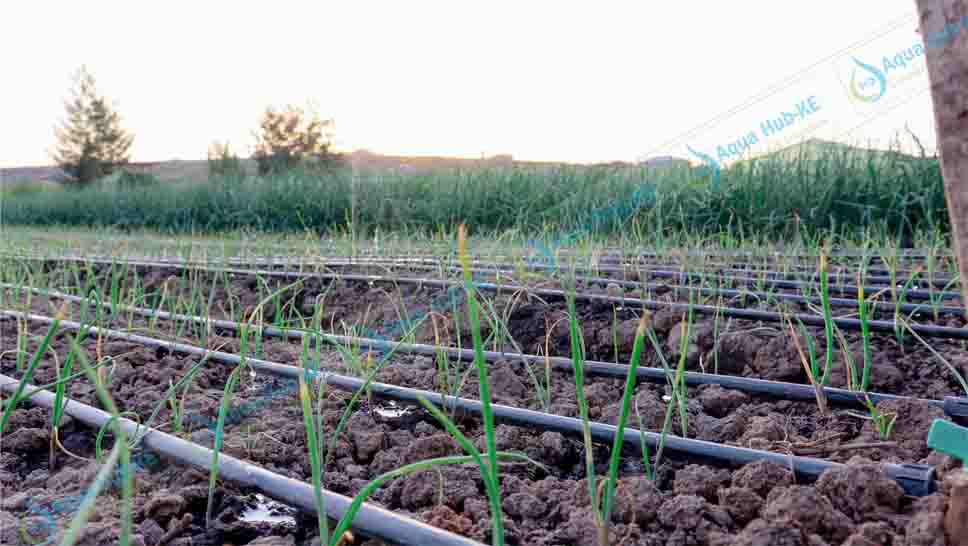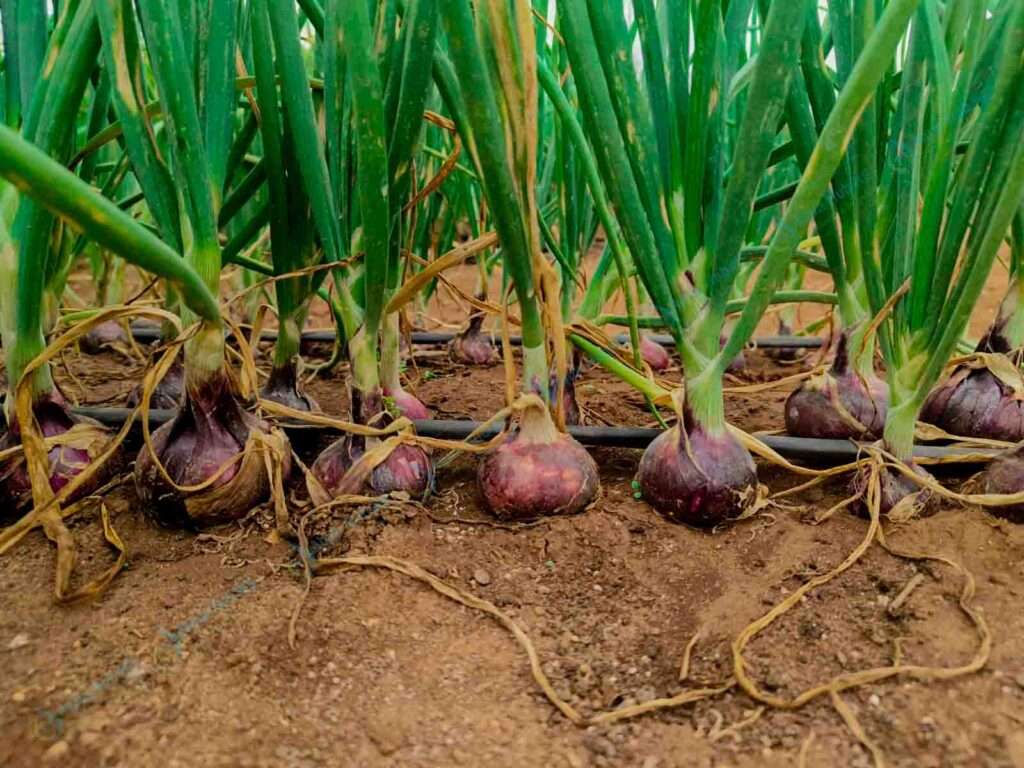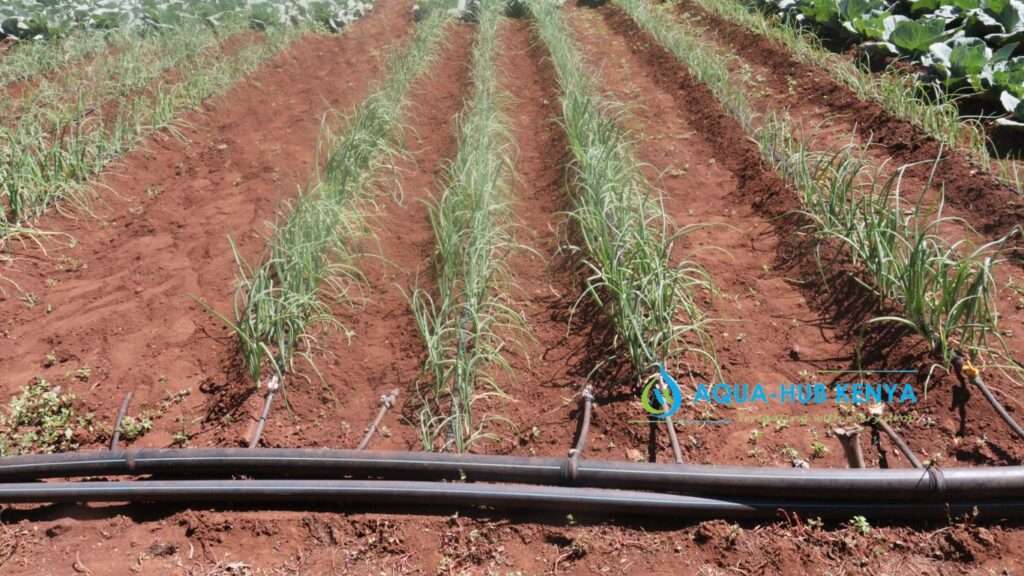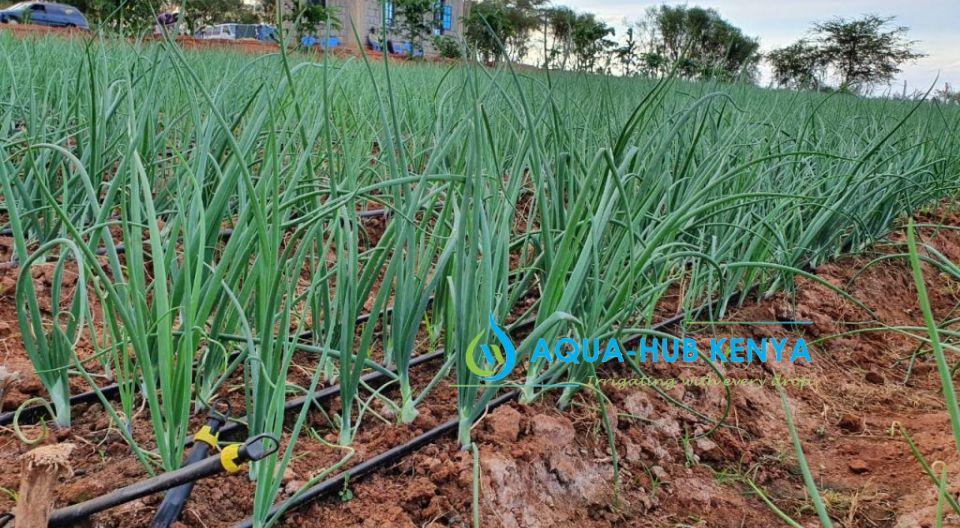Onion Production in Kenya
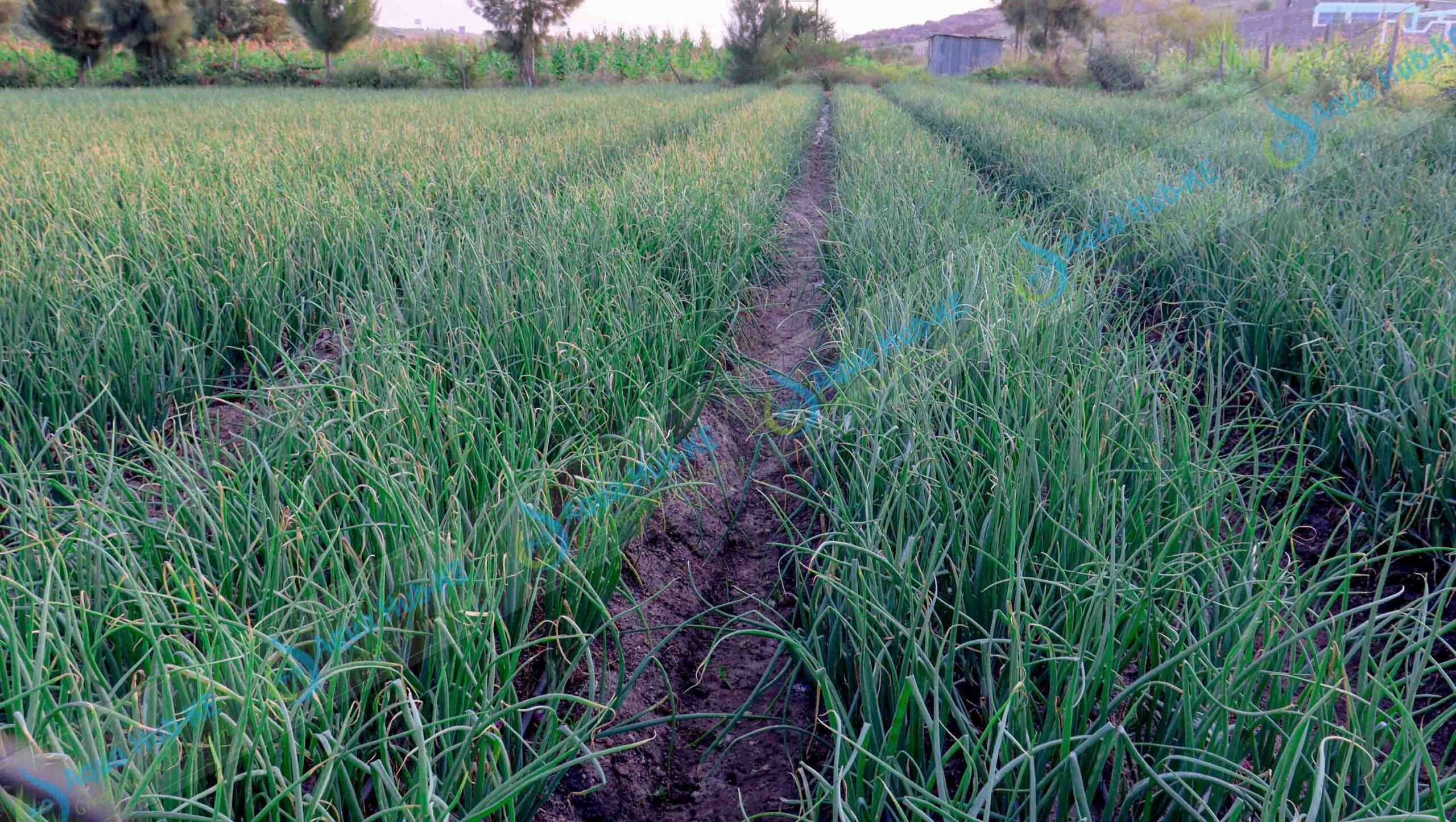
Onion production farming is a high potential agricultural sector in Kenya, with a near-ready market demand for the produce.
For Onions Drip Kits per Acre, Call Aqua Hub, Kenya : 0790719020
The conditions of most climatic regions in Kenya favor the cultivation of onions based on temperature, water, and soil PH. Harvested Bulb onions can remain fresh for many days in groceries, vegetable stalls, and other storage facilities.
Profitability of Onion Farming in Kenya
Onion farming in Kenya can be quite profitable when done right. 1acre of bulb onions can yield 20,000 kgs and with the current market price of onions which is at least 60/- per keg you can earn approx. KES. 1,200,000. However, like any agricultural venture, it comes with a few challenges and risks.
What determines Profitability in Onion Production
The overall yield and market value of onions will affect the profitability of your onion production venture.
To ensure high-profit realization in onion production farming, work needs to be done on reducing production costs. You may think of cutting down costs by raising your seedlings, applying low-cost but quality irrigation, and improving yield with effective practices.
Note; The quality and size of onion bulbs determine the price in some cases.
Tips for Profitability
- Hybrid or Certified Onion Seedlings: Planting hybrid onion varieties that do well in the Kenyan climate.
- Value Addition: Value addition may involve post-harvest drying to prevent rotting.
- Proper Watering and Nutrition: bulb and Spring onions will grow to their full potential with proper fertilizer and water supply.
While specific profit margins can vary depending on various factors, many farmers in Kenya have reported substantial returns on investment in onion farming
Reasons to Venture into Onion Production Farming in Kenya
Onion farming in Kenya presents a promising opportunity for people interested in venturing into the agricultural sector.
High Market demand for Onions
Onions are highly dependable as the main spice in the preparation of most delicious food types.
The demand for onion exceeds the Kenyan market to international markets in East Africa and overseas countries.
Favorable Climatic Conditions
Onion varieties thrive well in most climatic regions of Kenya, as they can be grown under irrigation in arid regions.
Proper Irrigation practices sustain onion production throughout the year.
More Profitable compared to Other Crops
Short Production Period: Propagation to harvest takes a short time (3-4) and enhances propagation up to 3 times.
Cost of Onion Production in Kenya
The cost of onion farming in Kenya is reliant on factors.
- Farm Size: Onion cultivation will depend on the size of your farm whether small or large scale.
- Irrigation Model: The cost of supplying water to onions varies as per the method.
- Inputs : Inputs such as fertilizers, and nutrients.
- Seedlings: seedling propagation and purchase cost.
- Labour Cost: Cost incurred in farm preparation, propagation, weeding, and irrigation installation.
Average Cost Estimates
The cost of Onion Production in Kenya is KES 200,000 to KES 350,000 per acre for new farmers.
Breakdown of Onion Production Costs
Cost may be broken down into various onion production steps.
- Land preparation includes the costs that you incur in clearing, digging, and preparing beds.
- Seedling Propagation phase: Cost incurred in the purchase of seedlings and sowing process.
- Planting stage: Cost of fertilizer, planting labor cost.
- Irrigation installation: Drip Kits cost and installation costs.
- Weeding and Pest Control: the cost of expenditure on weeding, pesticides, and insecticides.
- Transportation: Costs for transporting produce to the market.
- Storage: If you plan to store onions, consider storage costs.
Ways to Lower Production Costs
- Efficient water management: Optimize water usage to reduce costs.
- Effective Pest Control: Use recommended pesticides.
- Employing smart automation irrigation: to lower costs of labour needs in irrigation.
Onion Production: Varieties to Grow in Kenya
Within the favorable climatic regions in Kenya, several varieties include;
- Red Creole: Popular due to its medium size and red appearance.
- Bombay Red: Large bulb size, deep red color and pungent smell.
- Bombay White: Known for its mild flavor and white color.
- Tropicana F1: This hybrid variety offers high yields and resistance to certain diseases.
- Pearl Drop: This variety produces small, round onions with a strong flavor.
Important Things to Consider When Choosing an Onion Variety
- Soil type and PH: choose a variety that is recommended for your soil PH.
- Market demand: Study the market demand and consider the variety with high demand.
- Yield: Choose varieties known for high production.
- Disease resistance: opt for varieties that are resistant to common onion diseases.
- Maturity period: Selection should also be based on the average production period. Choose a variety with a shorter production season.
Tips for Proper Onion Variety Selection
- Seek advice from experts or agronomists: They often measure soil samples and recommend the best variety to grow.
- Consider hybrid varieties: These often offer higher yields and better disease resistance.
Preparing the Soil
- Clear the land: Remove any weeds or debris.
- Tilling: Break up the soil to improve aeration.
- Fertilization: Add organic matter like compost or manure to enrich the soil.
Preparation of Beds
Onion production requires raised beds for seedling propagation and transplanting to the farm.
Seedling Beds may take a width of 1 M and a length of 100 M maximum on a drip irrigation layout.
The bed size can also depend on the number of drip lines laid, which varies.
3 Lines per Bed
The production of onions on a farm section of 3 drip lines.
4 Lines per Bed
Beds may take 4 drip lines to supply water to more than 4 lines of onion plants
Planting
- Timing: The best planting time depends on the region. Consult local farmers or agricultural extension offices.
- Method: You can plant onion seeds directly or use onion sets.
- Spacing: Plant onions in rows with adequate spacing for proper growth.
Onion Production: How to Irrigate Onions
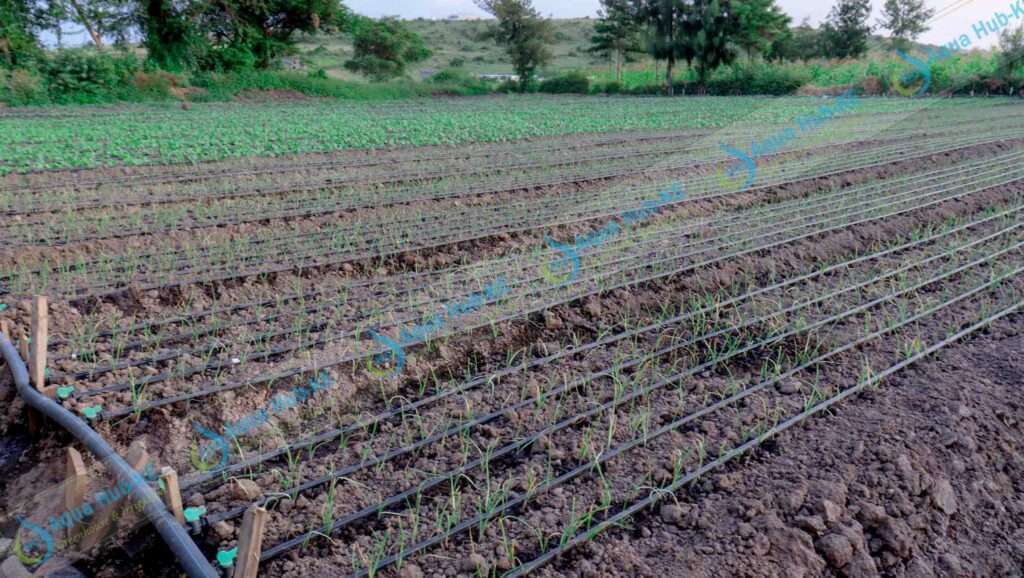
Onions tend to produce big, healthy bulbs when sufficient water is fed over the growth season. Control in irrigation is ideal to keep the plants from excess watering, a threat to faster growth.
Top Irrigation Methods for Onion Production in Kenya
Surface Irrigation (Furrow)
Avails water through furrows in between beds or rows. Soil beds soak water for the growth of the onion seedlings.
Drip Irrigation
Waters the onion plants in an efficient and precise manner. Irrigation targets the root zones of the onion plants, minimizing water loss and risk of leaf infections.
Overhead Irrigation
Makes use of sprinkler irrigation mode where water falls to the soil from above the leaves. Contact with the onion leaves causes fungal infections such as rust and pesticides are costly
How Much Water is Ideal to Irrigate Onions?
Onions require 1 inch deep of water per week, adjusting based on weather conditions and soil type.
Water Requirement in Onion Production Stages
- Transplanting – Plant intake is high during transplanting. Irrigation daily is important is ideal.
- Bulb Formation stage: Increase water frequency once the onions are 6-8 weeks old (Onion bulb formation)
- Curing: Reduce watering as harvest approaches to encourage bulb maturity.
Drip Irrigation: The Best Choice for Onion Production
Meeting water requirements and growing conditions is Key to attaining higher yields. Drip irrigation leaves soil within the recommended moisture level, nutrient level, temperature, and compactness.
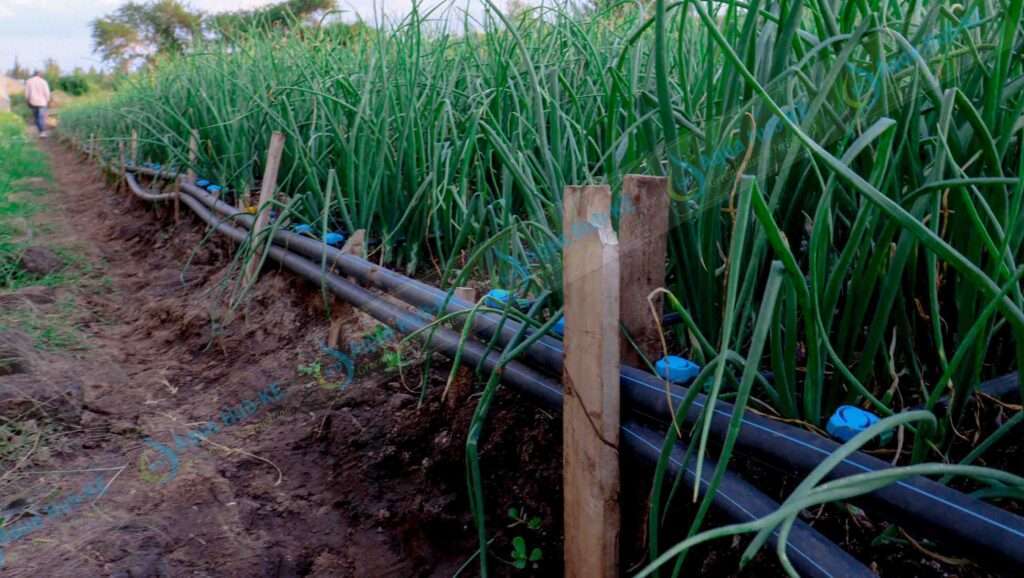
Efficiency of Drip Irrigation Over Other Irrigation Methods
- Precision watering: Delivers water directly to the root zone, preventing waterlogging and diseases.
- Water conservation: Highly efficient, minimizing water wastage.
- Fertilizer application: Allows for precise fertilizer application through the irrigation system (fertigation).
- Disease prevention: Keeps leaves dry, reducing the risk of fungal diseases.
- Improved yield: Consistent moisture supply leads to higher onion yields and better quality.
- Labor efficiency: Requires less labor compared to other methods.
While other methods like furrow irrigation can be used, they are generally less efficient and can lead to issues like waterlogging and disease.
Recommended Drip Kit Supplier: Aqua Hub Kenya
We are Specialists in drip irrigation solutions for onion Production. Our services include sale of irrigation kits and installation services.
Call 07090719020
Care and Maintenance of Onion Plants
Ensure optimal water supply, especially on low-moisture soil.
Keep your onion beds weed-free to prevent competition for resources.
Apply balanced fertilizer rates as per crop needs.
Harvesting Of Onions
Harvesting begins when onion leaves dry up completely to the base of the crop.
The recommended harvesting technique involves digging out and cutting the roots.
Post-Harvest Handling
- Curing: Proper curing helps to extend the onion’s shelf life.
- Storage: Store onions in a cool, dry place with good ventilation.

